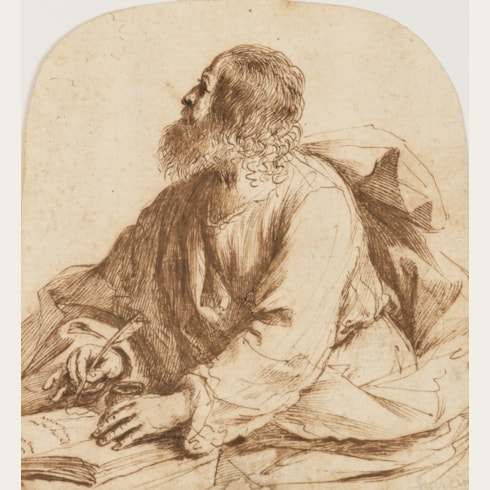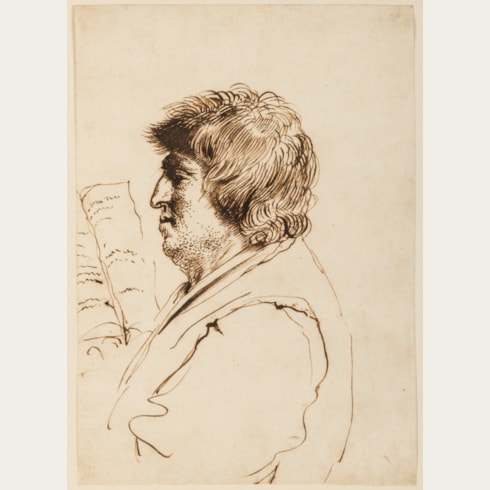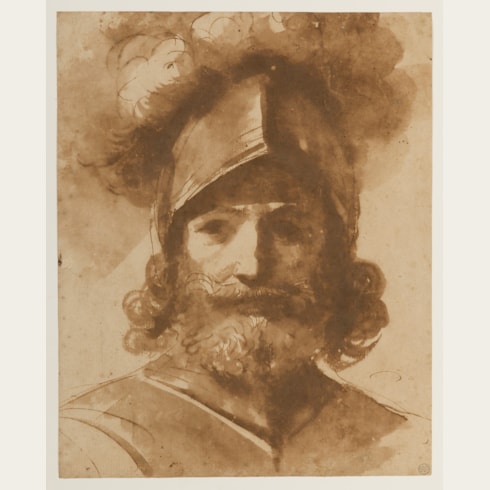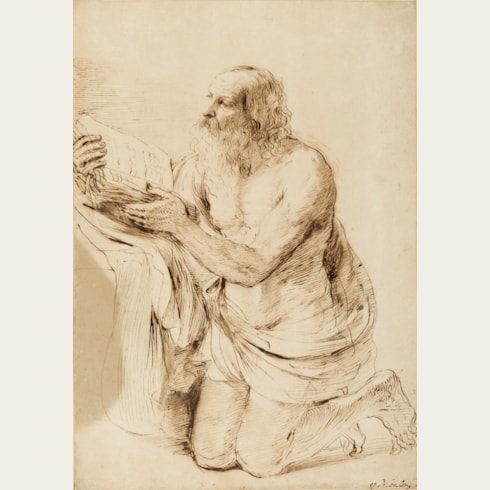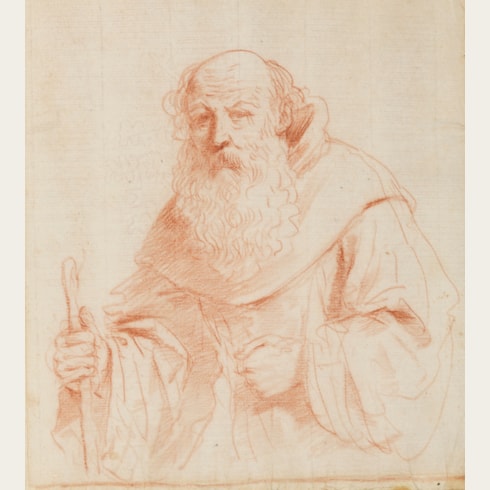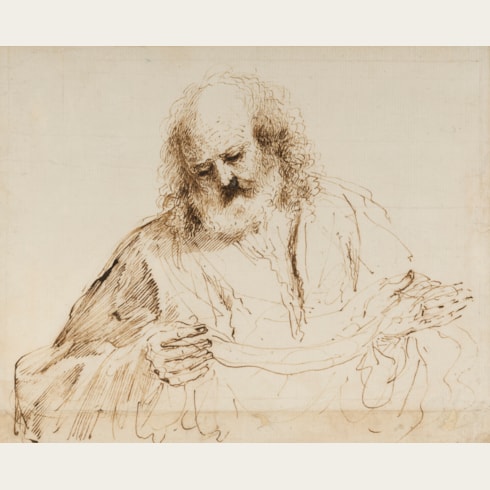Giovanni Francesco Barbieri GUERCINO
(Cento 1591 - Bologna 1666)
King David with his Harp
Inscribed guercino in brown ink at the lower right.
Further inscribed Le Guerchin and Gio Francesco Barbieri / da Cento 1590 + 1666 on the verso.
134 x 129 mm. (5 1/4 x 5 1/8 in.)
Nicholas Turner has recently suggested that both the British Museum and Goldman drawings, and by extension the present sheet, may be first ideas for Guercino’s painting of King David Rending his Garments of 1637, formerly in the collection of the Bob Jones University Museum in Greenville, South Carolina, and lately sold at auction in France. The canvas is listed in the Libro dei Conti under 14 July 1637, when the artist was paid fifty ducats by a Monsignor Gorri, Vice Legate of Bologna, for ‘una mezza figura di un David Profeta fatto in atto di rompersi gli habiti propri.’ A red chalk drawing by an artist in Guercino’s circle, now in the collection of the Albertina in Vienna, depicts the same subject as the painting of King David Rending his Garments of 1637, albeit in reverse, and is likely to be a copy of a lost autograph drawing for the picture.
The existence of three other half-length drawings of King David by Guercino, each of which show the figure looking upwards but not in the act of tearing his vestments, has led Turner to suggest that Guercino may have originally planned the painted composition quite differently, with David leaning on his harp. As Turner hypothesizes, ‘It is likely that Monsignore Gorri was offered a more conventional composition of King David, half-length, as attested by two original drawings [ie. the British Museum and Goldman drawings], both datable on stylistic grounds to the mid-1630s…which show him half-length, looking heavenwards.’ Of the other two related drawings of this subject, the present sheet is closest in composition to the study in the British Museum, notably in the angle of David’s head and the position of his right arm and hand.
Two later pen and ink drawings by Guercino of King David accompanied by his harp – one in the Berkeley Art Museum and Pacific Film Archive at the University of California and the other in a private collection - as well as a black chalk study of the same subject formerly in the Mariette collection and now in the Louvre, show the Biblical monarch as a somewhat older and more pensive figure. All three drawings, which may be dated to around 1650, lack the overt emotion evident in the present sheet and its related studies, as well as the 1637 canvas, and are likely to be related to a later painting of King David, albeit without his harp, commissioned from the artist in 1651 and today on loan from the Rothschild Collection to Waddeson Manor in Buckinghamshire.
A native of Alsace, the art historian and museum curator Hans Haug (1890-1965) served as director of both the Musée des Beaux-Arts and the Hohenlohemuseum (later renamed the Musée des Arts Décoratifs) in Strasbourg, from 1919 until his retirement in 1963.
Giovanni Francesco Barbieri, known as Il Guercino (‘the squinter’) because he was cross-eyed, was by the second decade of the 17th century one of the leading painters in the province of Emilia. Born in Cento, a small town between Bologna and Ferrara, Guercino was largely self-taught, although his early work was strongly influenced by the paintings of Ludovico Carracci. In 1617 he was summoned to Bologna by Alessandro Ludovisi, the Cardinal Archbishop of Bologna, and there painted a number of important altarpieces, typified by the Saint William Receiving the Monastic Habit, painted in 1620 and now in the Pinacoteca Nazionale in Bologna. When Ludovisi was elected Pope Gregory XV in 1621, Guercino was summoned to Rome to work for the pontiff and his nephew, Cardinal Ludovico Ludovisi. It was in Rome that Guercino painted some of his most celebrated works, notably the ceiling fresco of Aurora in the Casino Ludovisi and the large altarpiece of The Burial and Reception into Heaven of Saint Petronilla for an altar in Saint Peter’s. The papacy of Gregory XV was short-lived, however, and on the death of the Pope in 1623 Guercino returned to his native Cento. He remained working in Cento for twenty years, though he continued to receive commissions from patrons throughout Italy and beyond, and turned down offers of employment at the royal courts in London and Paris. Following the death of Guido Reni in 1642, Guercino moved his studio to Bologna, where he received commissions for religious pictures of the sort that Reni had specialized in, and soon inherited his position as the leading painter in the city.
Guercino was among the most prolific draughtsmen of the 17th century in Italy, and his preferred medium was pen and brown ink, although he also worked in red chalk, black chalk, and charcoal. He appears to have assiduously kept his drawings throughout his long career, and to have only parted with a few of them. Indeed, more drawings by him survive today than by any other Italian artist of the period. On his death in 1666 all of the numerous surviving sheets in his studio passed to his nephews and heirs, the painters Benedetto and Cesare Gennari, known as the ‘Casa Gennari’.
The drawings of Guercino, which include figural and compositional studies, landscapes, caricatures and genre scenes, have always been coveted by later collectors and connoisseurs. Indeed, the 18th century amateur Pierre-Jean Mariette noted of the artist that ‘Ce peintre a outre cela une plume tout-à-faite séduisante’. The largest extant group of drawings by Guercino is today in the Royal Collection at Windsor Castle; these were acquired from the Gennari family by King George III’s librarian, Richard Dalton, between about 1758 and 1764.
Provenance





















